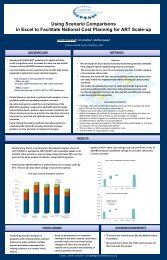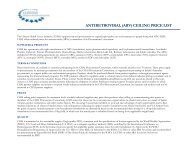HIV/AIDS in Ethiopia: - Clinton Health Access Initiatives
HIV/AIDS in Ethiopia: - Clinton Health Access Initiatives
HIV/AIDS in Ethiopia: - Clinton Health Access Initiatives
You also want an ePaper? Increase the reach of your titles
YUMPU automatically turns print PDFs into web optimized ePapers that Google loves.
EXECUTIVE SUMMARYS<strong>in</strong>ce the turn of the century, the global ecosystem of world’s most studied disease—<strong>HIV</strong>/<strong>AIDS</strong>—has experienced vital transformation. Motivated <strong>in</strong> no small part by generous <strong>in</strong>creases<strong>in</strong> disease-specific official development assistance (ODA) and a re-committed focus by worldleaders, major advancements <strong>in</strong> the fight to control <strong>HIV</strong>/<strong>AIDS</strong> have begun to take hold. In<strong>Ethiopia</strong>, these transformations have produced deep and widespread changes <strong>in</strong> the nationallandscape of public health.Play<strong>in</strong>g a major role <strong>in</strong> combat<strong>in</strong>g <strong>HIV</strong>/<strong>AIDS</strong> <strong>in</strong> <strong>Ethiopia</strong> are newly emergent <strong>in</strong>ternationalactors who, despite ever-<strong>in</strong>creas<strong>in</strong>g budget tighten<strong>in</strong>g and global f<strong>in</strong>ancial uncerta<strong>in</strong>ty, havedeveloped <strong>in</strong>novative ways to f<strong>in</strong>ance solutions to some of our generation’s greatest globalhealth challenges. No better organization fits this description than UNITAID. Aris<strong>in</strong>g from anunwaver<strong>in</strong>g commitment to develop unique and <strong>in</strong>novative f<strong>in</strong>anc<strong>in</strong>g solutions to combat<strong>HIV</strong>/<strong>AIDS</strong>, malaria and tuberculosis, UNITAID has provided over $1.5 billion <strong>in</strong> health fund<strong>in</strong>g,effectively treat<strong>in</strong>g nearly 50 million people throughout 94 countries worldwide. 1In <strong>Ethiopia</strong> alone, UNITAID—<strong>in</strong> collaboration with The Cl<strong>in</strong>ton <strong>Health</strong> <strong>Access</strong> Initiative—hasfunded the procurement of nearly $15 million USD worth of <strong>HIV</strong>/<strong>AIDS</strong> commodities betweenJune 2007 and May 2011. This report is a summary of the progress made <strong>in</strong> the diagnosis andtreatment of <strong>HIV</strong>/<strong>AIDS</strong> <strong>in</strong> <strong>Ethiopia</strong> with the contribution of those funds.develop new guidel<strong>in</strong>es for the use of ready-tousetherapeutic food (RUTF)—more commonlyknown as Plumpy’nut. Start<strong>in</strong>g <strong>in</strong> 2009, RUTFwas fully <strong>in</strong>corporated <strong>in</strong>to the <strong>Ethiopia</strong>’spharmaceutical supply and distribution system.LABORATORY SERVICESLaboratory Services coord<strong>in</strong>ates with the<strong>Ethiopia</strong>n <strong>Health</strong> and Nutrition ResearchInstitute (EHNRI) to implement programsaimed at improv<strong>in</strong>g the quality of the nation’slaboratory system. The SMS Pr<strong>in</strong>ter Projectis an example of such an <strong>in</strong>itiative. Piloted <strong>in</strong>2009 with fund<strong>in</strong>g from UNITAID, SMS pr<strong>in</strong>tersimprove patient care by expedit<strong>in</strong>g test resultsfrom central labs to rural health facilities.Currently, 25 health facilities are equipped withthe new technology. The pediatric <strong>HIV</strong> test<strong>in</strong>g<strong>in</strong>itiative known as Early Infant Diagnosis (EID)is another laboratory program facilitated byCHAI and funded by UNITAID with operations<strong>in</strong> health facilities nationwide. By scal<strong>in</strong>g upcapacity <strong>in</strong> the EID program—1,840 tests wereperformed <strong>in</strong> 2007 and 24,500 are estimatedto be performed <strong>in</strong> 2011—thousands ofotherwise-undiagnosed <strong>Ethiopia</strong>n children areable to receive essential ARV treatment. 3SUMMARY OF UNITAID COMMODITY FUNDING * CHAI and UNITAID <strong>in</strong> <strong>Ethiopia</strong> 2S<strong>in</strong>ce the launch of the CHAI/UNITAID Pediatricantiretroviral therapy (ART) program <strong>in</strong> 2007,<strong>Ethiopia</strong> has experienced a 486% <strong>in</strong>creasethe number of children receiv<strong>in</strong>g therapy.This equates to over 14,000 <strong>HIV</strong> positivechildren receiv<strong>in</strong>g ART today. On a globalscale, CHAI/UNITAID <strong>in</strong>itiatives have led to thedevelopment of fixed-dose comb<strong>in</strong>ation drugs(FDCs) for pediatric ART. Quickly adoptedand recommended as the primary method ofpediatric treatment by the <strong>Ethiopia</strong>n FederalM<strong>in</strong>istry of <strong>Health</strong> (FMoH), FDCs offerednumerous advantages over exist<strong>in</strong>g syrupformulations, show<strong>in</strong>g marked improvement<strong>in</strong> patient compliance and distribution. Today,full access to free pediatric ART is providedthroughout <strong>Ethiopia</strong>.1SUMMARY OF PROGRAM ACCOMPLISHMENTSpediatric ARV SCALE UPAdult 2nd l<strong>in</strong>e ARV SCALE UPIn 2007, the price of 2nd l<strong>in</strong>e ART regimenswere roughly 10 times more expensive than1st l<strong>in</strong>e therapies. As 1st l<strong>in</strong>e treatmentpopulations grew and patients cont<strong>in</strong>uedto live longer, so, too, grew the demand for2nd l<strong>in</strong>e ART. By address<strong>in</strong>g <strong>in</strong>efficiencies <strong>in</strong>the relatively nascent-stage 2nd l<strong>in</strong>e therapymarket, <strong>in</strong> less than five years, CHAI/UNITAIDeffectively reduced the annual cost of treat<strong>in</strong>gpatients with a comb<strong>in</strong>ation of Tenofovir (TDF),Lamivud<strong>in</strong>e (3TC) and Lop<strong>in</strong>ovir/ritonavir (LPV/r)—a popular 2nd l<strong>in</strong>e ART regimen—by over50%. 2Ready-to-use therapeuticfoodChild malnutrition is a major public healthconcern <strong>in</strong> <strong>Ethiopia</strong>. In an effort to improveexist<strong>in</strong>g treatment programs for <strong>HIV</strong>positive children suffer<strong>in</strong>g from severeacute malnutrition (SAM), CHAI/UNITAIDcollaborated with the <strong>Ethiopia</strong>n government toSource: 1 UNITAID; 2 2007 WHO GPRM pric<strong>in</strong>g for Low Income countries and 2011 lowest UNITAID pric<strong>in</strong>g; 3 EHNRIINITIATIVE 2007 2008 2009 2010 2011 GRAND TOTAL PEDIATRIC ART $819,791 $1,921,518 $1,095,899 $1,720,731 $464,022 $6,021,961 2ND LINE ADULT ART $543,482 $1,041,223 $1,644,007 $555,657 $0 $3,784,369 RUTF $215,824 $1,373,404 $934,950 $498,525 $0 $3,022,703 LAB & DIAGNOSTICS $122,281 $360,299 $478,519 $852,383 $143,024 $1,956,506 $1,701,378 $4,696,444 $4,153,375 $3,627,296 $607,046 $14,785,539 UNITAID CONTRIBUTION BY PROGRAMPEDIATRIC ART 2ND LINE ART LAB & DIAGNOSTICS RUTF * The stated number reflects commitments for products purchased <strong>in</strong> the noted budget year. Actual paymentsaga<strong>in</strong>st orders are made as products are delivered, so some payments will be made <strong>in</strong> the follow<strong>in</strong>g year.




